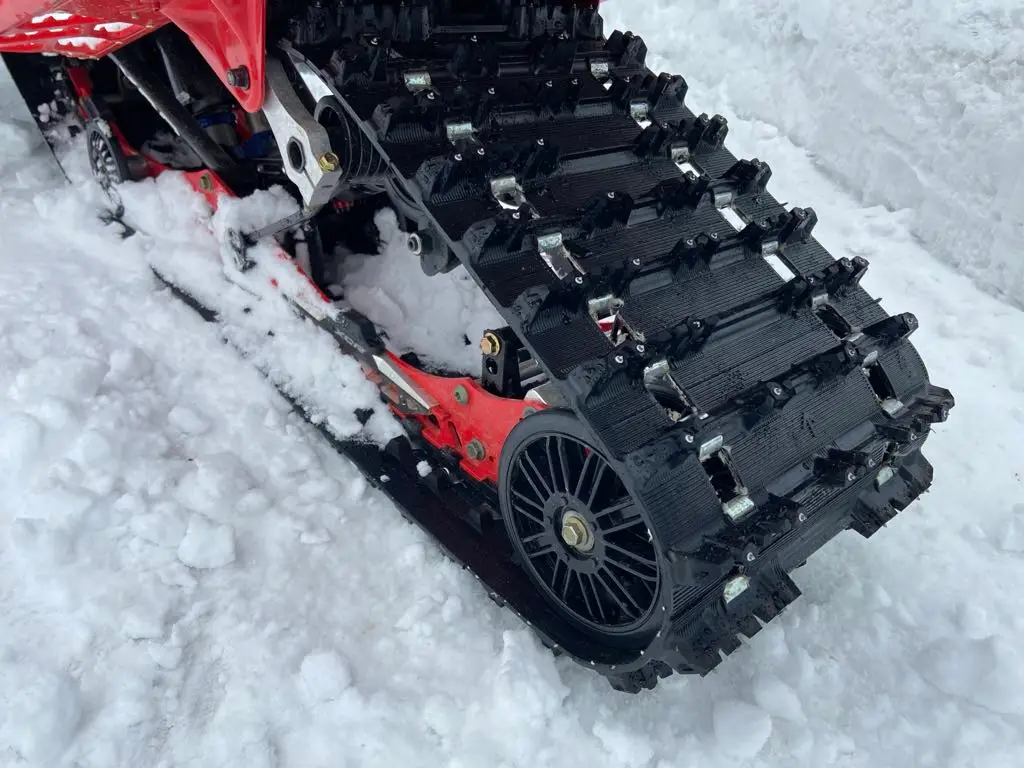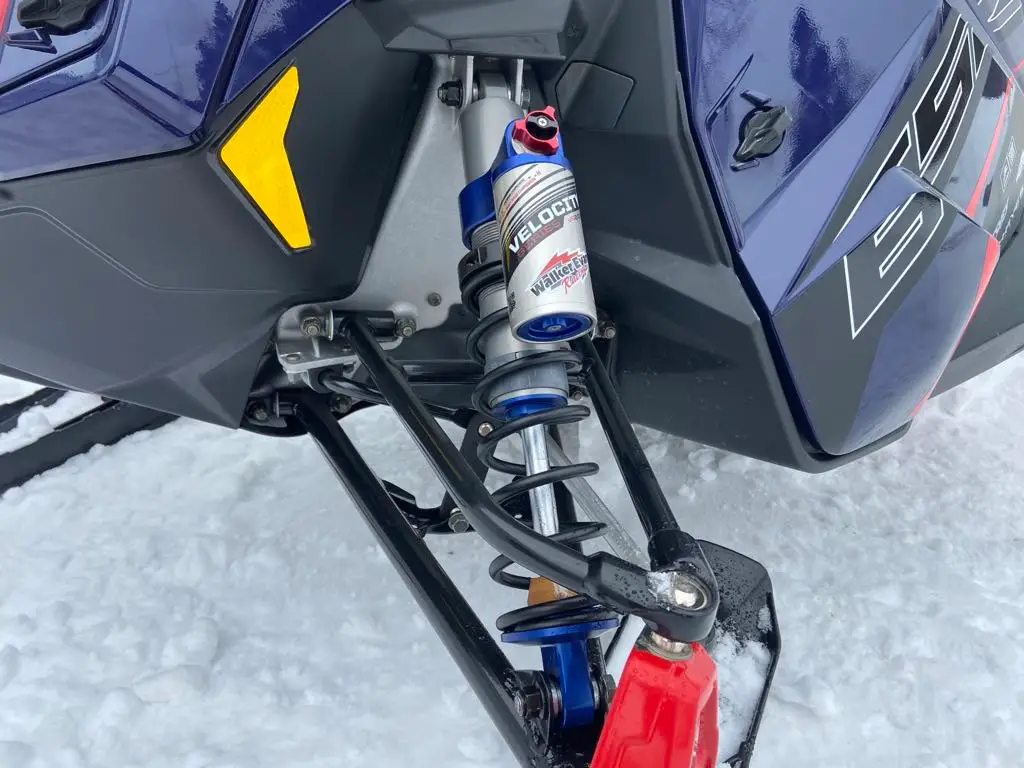Table of contents
ToggleWinter 2025 was an emotional rollercoaster for me. The season took its time laying down a proper white carpet to enjoy one of my favourite activities. On top of that, the wait felt endless, as I had a brand-new snowmobile just sitting in my garage, ready to roar. And this wasn’t just any snowmobile—it came with a rich heritage and a solid reputation for high-performance trail riding. I’m talking about the Polaris 650 INDY XCR 2025.
The XCR badge means this sled draws directly from Polaris’ cross-country racing efforts. That’s clear from its reinforced rear suspension, high-performance quick-grab brake, large-capacity Walker Evans Velocity shocks with high- and low-speed external compression damping, and several other features. With an XCR, expectations are high. But does it live up to the hype?
A Season Slow to Start…
I had high hopes as December rolled in cold, but the snow didn’t follow. I had to be patient. Still, I shared my early-season expectations and pre-ride impressions in a previous review.
It was frustrating—very frustrating. I had this shiny new machine, and all I could do was stare at it, dreaming of the day I could unleash it on snowy trails. But as the saying goes, good things come to those who wait.
Finally—Snow!
I can tell you right now, it was worth the wait. Polaris’ INDY XCR is known for tackling the toughest trail abuse. “That’s perfect—it’s exactly my style!” As someone who’s always lived in the Lanaudière region, I’ve grown up on vast, flat areas ideal for trail riding.
Long straightaways followed by sweeping curves are my daily norm. Ever-changing weather and strong winds tend to beat up my playground quickly. Having a sled that can handle any terrain is a real asset for me.
My Polaris 650 INDY XCR 2025 delivered exactly what I wanted: versatility and agility. I’ve said it before and I’ll say it again—it fits me like a glove. It feels as if it was moulded just for me. The Matryx chassis was clearly designed by riders, for riders. Everything is laid out so intuitively. The moment I step behind the bars, it feels like home.

Almost Perfect… With One Annoyance
Yes, I know I’m repeating myself, but I can’t ignore how awful the mirrors are. I can’t believe engineers thought mounting mirrors on the corners of the side panels was a good idea. I hate having to take my eyes off the trail, crane my neck to look under my arm, and try to interpret what I see in those tiny things—all in a split second while still watching the trail ahead.
They do look great, I’ll give them that. But from a functional point of view, I’ll take handlebar-mounted mirrors any day.
Is the 650 Patriot Engine Enough?
Let’s remember that 2025 marked the introduction of the Patriot 9R engine in trail sleds. It’s a powerhouse that has changed the game and given the XCR lineup a massive reputation boost. With nearly 180 hp and tons of mid-range torque, the 9R is a beast. But do we really need that kind of engine for everyday trail riding? I’d say no.
In my opinion, the 650 Patriot engine—featured in my test sled—delivers more than enough power to satisfy 95% of riders. Its acceleration is so snappy that it almost feels like an 850. Honestly, the only time you’ll really notice the difference between the 650 and 850 is at speeds beyond 140–150 km/h*. At that point, the 650 starts to run out of breath and shows its limits.
*This type of testing is done in a controlled environment for evaluation purposes only. We do not promote excessive speed. Remember, the speed limit on federated trails is 70 km/h.
When riding in northern Lanaudière through mostly forest trails, the 650 Patriot’s agility gave me everything I needed. I could carve confidently through corners with plenty of power.
ICE RIPPER XT Track
When pre-ordering, one of the options I chose was the ICE RIPPER XT track (15 × 136 × 1.25 in). The built-in studs offer extra grip on icy surfaces. That said, don’t expect miracles. While they do help, you still need to feather the throttle, as sliding is still a regular occurrence.
This track does give me extra confidence on trails, although it does leave marks on my garage floor. I have to be gentle when backing it out, as a sudden slip of the track can happen fast.

Tech at Your Fingertips
One of my favourite tools for any adventure is the RIDE COMMAND system. Ironically, it was designed to disconnect us from the rest of the world. Polaris off-road vehicles are supremely capable of taking us to places most people will never see. Yet RIDE COMMAND—and now RIDE COMMAND+—can keep us connected, help us navigate to and from our destination, and stay in touch with the outside world. What began as a basic trail GPS has evolved into a trail tool and problem-solver I rely on.
Simplicity is the name of the game for RIDE COMMAND. It’s like having a reassuring assistant showing me the real-time location of my riding buddies (as long as they also ride a Polaris). I love being able to check the map to plan my route on a “nowhere” ride. It allows me to make loops without retracing my steps. That said, I’ve run into some trail sections that still appeared on the map but were no longer accessible. It’s effective, but not 100% foolproof.
It’s super easy to set up and it connects to my phone effortlessly. When my spouse calls, I can see it right in the middle of the screen, and I can answer using my helmet comms system.
The display is clear and customizable—I can arrange the info however I want. For me, it’s the best screen available across all brands.

A Proven Suspension
The impressive handling of the Polaris 650 INDY XCR 2025 comes from a suspension perfectly tailored to its mission. One major improvement I noticed was faster weight transfer to the skis thanks to the coupling system, which helped with cornering. The sled still lifts, but only when I want it to. The suspension reacts more quickly to trail vibrations because of how the spring movement and shock travel are separated in the first few centimetres of stroke.
This sled handles incredibly well and can tackle the roughest trails and approaches with finesse. It carves tight, twisty trails effortlessly.

Upgrades Coming for 2026
I’d be remiss not to mention the PRO-CC suspension upgrades coming for 2026. Called “Longtail,” it features a much more forward-mounted lower torsion spring support. It’s actually positioned in front of the rear mount of the front torque arm. This setup has been used on Polaris cross-country race circuits over the past two seasons. According to the company, the new geometry comes with a 20% more aggressive suspension calibration. I got a sneak peek of this setup during the last SnowShoot in Montana. I’ll save my detailed thoughts for another article next season after a long-term test of the 2026 Polaris XCR. Stay tuned!


